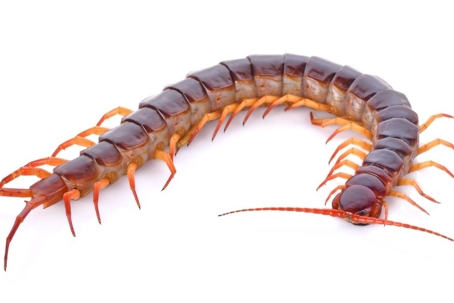Centipedes vs Millipedes
Identifying centipedes vs. millipedes can be important for a few reasons:
Pest control: Centipedes and millipedes can be considered pests if they are present in large numbers in or around your home. Identifying which type of arthropod you are dealing with can help determine the most effective method of control.
Medical concerns: While both centipedes and millipedes are generally harmless to humans, some species of centipedes can deliver painful bites that may require medical attention. Identifying the species of centipede can help medical professionals determine the appropriate treatment.
Ecological significance: Centipedes and millipedes play important roles in the ecosystems where they live. Identifying these arthropods can help scientists better understand the ecological relationships between different species and their roles in food webs.
Being able to distinguish between centipedes and millipedes can be useful for a range of practical and scientific reasons. Read on to learn more about the differences between the two.
Millipedes vs Centipedes
Centipedes and millipedes may look similar at first glance due to their long, segmented bodies and numerous legs, but there are some key differences between the two groups of arthropods:
Centipede vs Millipede Legs
The legs of centipedes and millipedes are one of the most noticeable differences between the two groups of arthropods. Here are some key differences:
Number of legs per segment: Centipedes have one pair of legs per body segment, while millipedes have two pairs of legs per segment.
Positioning of legs: In centipedes, the legs are positioned on the sides of the body and are often angled downward. In contrast, millipede legs are positioned directly underneath the body and are parallel to the ground.
Function of legs: The legs of centipedes are adapted for speed and hunting. They are long, slender, and often have sharp claws or spines that can grip and subdue prey. In contrast, the legs of millipedes are adapted for stability and locomotion. They are shorter and sturdier than centipede legs and are used to propel the body forward.
Overall number of legs: Centipedes have fewer legs overall than millipedes, with the number of legs ranging from 15 to over 300 pairs in centipedes, compared to 60 to over 750 pairs in millipedes.
While the legs of centipedes and millipedes may look similar at first glance, there are several key differences in their positioning, function, and overall number that distinguish the two groups of arthropods.
Millipede vs Centipede Size
Centipedes and millipedes differ in size, with millipedes generally being larger than centipedes. Here are some key differences:
Length: Centipedes are generally smaller than millipedes, with body lengths ranging from a few millimeters to about 30 centimeters, while millipedes can range from a few millimeters to over 30 centimeters in length.
Number of segments: Both centipedes and millipedes have segmented bodies, but millipedes typically have more segments than centipedes, which can contribute to their larger size.
Overall body size: In addition to their longer bodies, millipedes tend to be bulkier and heavier than centipedes, with some species reaching up to several hundred grams in weight.
Leg length: The length of legs also contributes to the overall size difference between centipedes and millipedes. Centipedes have long, slender legs that are adapted for speed and hunting, while millipede legs are shorter and sturdier, designed for stability and locomotion.
While there is some variation in size within both centipedes and millipedes, millipedes are generally larger and heavier than centipedes due to their longer bodies, greater number of segments, and bulkier build.
Body Shape & Color
The body shape of centipedes and millipedes is another noticeable difference between these two groups of arthropods. Here are some key differences:
Elongation: Centipedes have a flatter, more elongated body shape, while millipedes are more cylindrical in shape.
Segmentation: Both centipedes and millipedes have segmented bodies, but the segments are more distinct and pronounced in millipedes.
Head shape: The head of a centipede is flattened and triangular, with a pair of antennae and a pair of venomous claws or maxillipeds. In contrast, the head of a millipede is rounded and lacks venomous claws.
Coloration: Centipedes are often brightly colored, with yellow, red, or orange markings, while millipedes are typically darker in color, such as brown or black, with some species having bright patterns or markings.
While centipedes and millipedes may look similar in some ways, their body shapes are different, with centipedes having a flatter, more elongated body shape and a distinctive triangular head, and millipedes having a cylindrical body shape with a rounded head.
Millipede vs Centipede Poison
Centipedes and millipedes both produce defensive secretions, but the composition and effects of these secretions can vary between the two groups of arthropods.
Centipedes are predators and use venom to subdue and kill their prey. Their venom glands are located in their head and they have specialized, venomous claws called maxillipeds that are used to inject venom into their prey. The venom of centipedes typically contains a mixture of neurotoxins, enzymes, and other proteins that can cause pain, swelling, and other symptoms in humans if bitten. The severity of the symptoms can vary depending on the species of centipede and the individual bitten, with some species having more potent venom than others. In rare cases, bites from certain species of centipedes can be dangerous, especially to those with allergies or underlying health conditions.
Millipedes, on the other hand, produce a defensive secretion from their exoskeleton that is often foul-smelling and can contain a variety of chemicals that deter predators. The secretion is not venomous and is not harmful to humans, but it can cause irritation or allergic reactions in some people if it comes into contact with the skin or eyes.
While both centipedes and millipedes produce defensive secretions, the composition and effects of these secretions differ. Centipede venom is a potent neurotoxin used for predation, while millipede secretions are defensive and typically contain chemicals that are unpleasant or irritating to potential predators.

